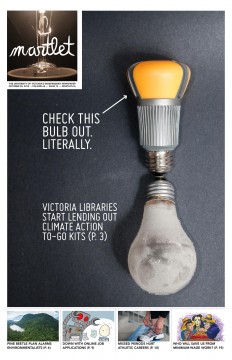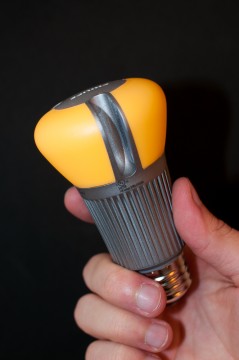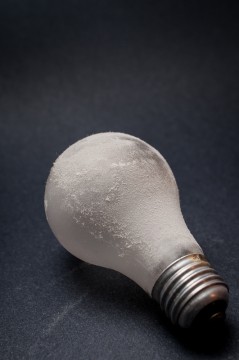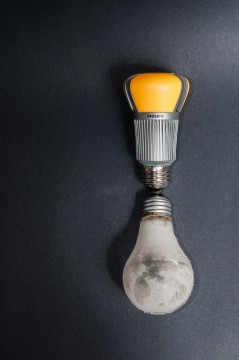Of the cover images I’ve made for the Martlet, this one is a definite favourite, and yet it was one of the most unlikely. When I was first assigned the task, I thought it would just be a snap of a plastic bucket of stuff, but if I’ve learned anything this year, it’s that my expectations are not to be trusted.
In one of our weekly meetings, we decided that the cover story would be about a new item for lending at local libraries: a kit that could help households conserve resources like power and water. Inside a clear plastic container were items like a thermal leak detector to discover air leaks in the home, a measuring bag for testing showerhead efficiency, and some instructional books and DVDs on conservation. While the tools were important, they weren’t very photogenic. I was left puzzled as to how to progress. That is, until I saw the LED light bulb.
Surprisingly well constructed and heavy in the hand, this plastic and metal bulb was unlike anything I had ever seen before, and I knew I had to make this the graphical focus of the photo, but that was about all I knew. Would I screw it into a lamp and make it glow? Surely not, as the bulb would be swallowed by my desk lamp. So, I thought of just holding it in my hand.
That was all right, but I felt I could do more. The black background, a sheet of poster paper from the dollar store, was good, but I remained unconvinced. Then, I thought about not photographing the new bulb and just photographing one of the LED bulb’s ancient ancestors. I had changed such a bulb a few weeks prior to the shoot and had marveled at just how much dust had settled on the top of it. I dug it out for the shoot and was glad that I had the foresight to keep it for a future photo shoot (which, incidentally, is my excuse for keeping all kinds of trash in the house). What was more startling was that the dust settled only on the top half of the bulb, leaving the rest perfectly clean. I knew I had to incorporate it somehow, but the photo still eluded me.
While thinking of a new strategy, I decided to play around with the items in the kit. The thermal leak detector, which resembled a flashlight that would change colour if it shone on cold zones in the house, entertained me for quite some time, and it had the added benefit of showing me where I needed to apply more caulk. With playtime over, I still couldn’t think of anything. I needed a fresh perspective, so that’s what I tried next.
All the photos I had taken of the bulb were at eye level, which abided by the rule that objects and people are more interesting when shot from their perspective, particularly baby photos. In some of the preliminary images, I was trying to contrast the new with the old, but if I shot from the top down, I could make a reflection image as well (further proof that strictly adhering to the “rules of photography” will often blind you to other opportunities).
I shot this with my camera held awkwardly out and over my head, all while trying to stop the incandescent bulb from rolling all over the place without disturbing the dust with my fingers. The bulbs were resting on a folding table, laying on a piece of paper partially taped to the wall to serve as a seamless backdrop. To my right was a single flash firing into a partially collapsed reflective umbrella (imagine a long cone shape) to limit the amount of light spill over the black background. The smaller light source would also enhance the texture of the dust thanks to harsher shadows. The image was deliberately cropped so that the two bulbs would meet exactly where the fold line would be on the actual newspaper, so when unfolded, the reflection would fully reveal itself.
I began the week with two difficult and puzzling photo subjects: a plastic bucket of stuff and a medical condition (yes, it was for the same issue). I ended it with two of my favourite images of the year. I could learn to live with these kinds of surprises.













